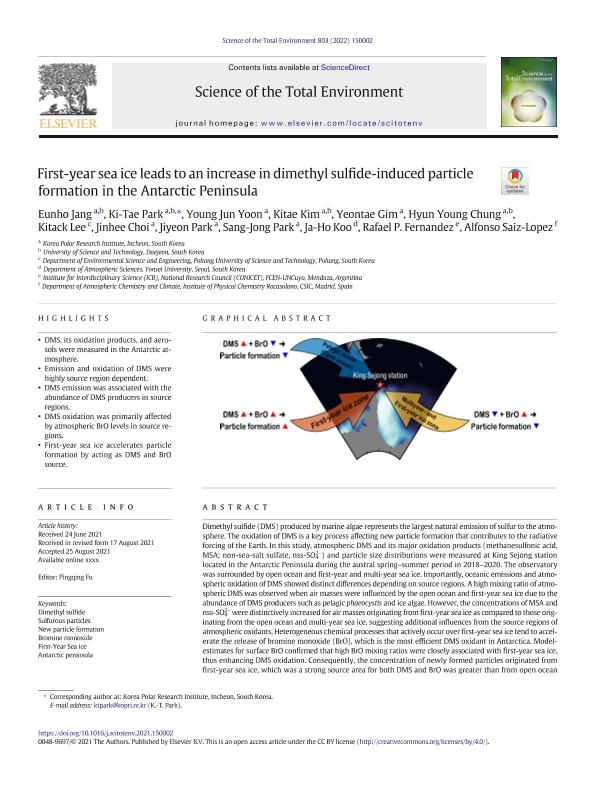Mostrar el registro sencillo del ítem
dc.contributor.author
Jang, Eunho
dc.contributor.author
Park, Ki-Tae
dc.contributor.author
Yoon, Young Jun
dc.contributor.author
Kim, Kitae
dc.contributor.author
Gim, Yeontae
dc.contributor.author
Chung, Hyun Young
dc.contributor.author
Lee, Kitack
dc.contributor.author
Choi, Jinhee
dc.contributor.author
Park, Jiyeon
dc.contributor.author
Park, Sang-Jong
dc.contributor.author
Koo, Ja-Ho
dc.contributor.author
Fernandez, Rafael Pedro

dc.contributor.author
Saiz López, Alfonso

dc.date.available
2024-04-15T17:47:58Z
dc.date.issued
2022-01-10
dc.identifier.citation
Jang, Eunho; Park, Ki-Tae; Yoon, Young Jun; Kim, Kitae; Gim, Yeontae; et al.; First-year sea ice leads to an increase in dimethyl sulfide-induced particle formation in the Antarctic Peninsula; Elsevier; Science of the Total Environment; 803; 10-1-2022; 1-9
dc.identifier.issn
0048-9697
dc.identifier.uri
http://hdl.handle.net/11336/233057
dc.description.abstract
Dimethyl sulfide (DMS) produced by marine algae represents the largest natural emission of sulfur to the atmosphere. The oxidation of DMS is a key process affecting new particle formation that contributes to the radiative forcing of the Earth. In this study, atmospheric DMS and its major oxidation products (methanesulfonic acid, MSA; non-sea-salt sulfate, nss-SO42?) and particle size distributions were measured at King Sejong station located in the Antarctic Peninsula during the austral spring?summer period in 2018?2020. The observatory was surrounded by open ocean and first-year and multi-year sea ice. Importantly, oceanic emissions and atmospheric oxidation of DMS showed distinct differences depending on source regions. A high mixing ratio of atmospheric DMS was observed when air masses were influenced by the open ocean and first-year sea ice due to the abundance of DMS producers such as pelagic phaeocystis and ice algae. However, the concentrations of MSA and nss-SO42? were distinctively increased for air masses originating from first-year sea ice as compared to those originating from the open ocean and multi-year sea ice, suggesting additional influences from the source regions of atmospheric oxidants. Heterogeneous chemical processes that actively occur over first-year sea ice tend to accelerate the release of bromine monoxide (BrO), which is the most efficient DMS oxidant in Antarctica. Model-estimates for surface BrO confirmed that high BrO mixing ratios were closely associated with first-year sea ice, thus enhancing DMS oxidation. Consequently, the concentration of newly formed particles originated from first-year sea ice, which was a strong source area for both DMS and BrO was greater than from open ocean (high DMS but low BrO). These results indicate that first-year sea ice plays an important yet overlooked role in DMS-induced new particle formation in polar environments, where warming-induced sea ice changes are pronounced.
dc.format
application/pdf
dc.language.iso
eng
dc.publisher
Elsevier

dc.rights
info:eu-repo/semantics/openAccess
dc.rights.uri
https://creativecommons.org/licenses/by/2.5/ar/
dc.subject
DMS
dc.subject
New Particle Formation
dc.subject
Bromine Chemistry
dc.subject
Antarctic Peninsula
dc.subject.classification
Geociencias multidisciplinaria

dc.subject.classification
Ciencias de la Tierra y relacionadas con el Medio Ambiente

dc.subject.classification
CIENCIAS NATURALES Y EXACTAS

dc.title
First-year sea ice leads to an increase in dimethyl sulfide-induced particle formation in the Antarctic Peninsula
dc.type
info:eu-repo/semantics/article
dc.type
info:ar-repo/semantics/artículo
dc.type
info:eu-repo/semantics/publishedVersion
dc.date.updated
2023-08-08T13:35:19Z
dc.identifier.eissn
1879-1026
dc.journal.volume
803
dc.journal.pagination
1-9
dc.journal.pais
Países Bajos

dc.journal.ciudad
Ámsterdam
dc.description.fil
Fil: Jang, Eunho. Korea Polar Research Institute; Corea del Sur. University of Science and Technology; Corea del Sur
dc.description.fil
Fil: Park, Ki-Tae. Korea Polar Research Institute; Corea del Sur. University of Science and Technology; Corea del Sur
dc.description.fil
Fil: Yoon, Young Jun. Korea Polar Research Institute; Corea del Sur
dc.description.fil
Fil: Kim, Kitae. Korea Polar Research Institute; Corea del Sur. University of Science and Technology; Corea del Sur
dc.description.fil
Fil: Gim, Yeontae. Korea Polar Research Institute; Corea del Sur
dc.description.fil
Fil: Chung, Hyun Young. University of Science and Technology; Corea del Sur. Korea Polar Research Institute; Corea del Sur
dc.description.fil
Fil: Lee, Kitack. Pohang University of Science and Technology; Corea del Sur
dc.description.fil
Fil: Choi, Jinhee. Korea Polar Research Institute; Corea del Sur
dc.description.fil
Fil: Park, Jiyeon. Korea Polar Research Institute; Corea del Sur
dc.description.fil
Fil: Park, Sang-Jong. Korea Polar Research Institute; Corea del Sur
dc.description.fil
Fil: Koo, Ja-Ho. Yonsei University; Corea del Sur
dc.description.fil
Fil: Fernandez, Rafael Pedro. Consejo Nacional de Investigaciones Científicas y Técnicas. Centro Científico Tecnológico Conicet - Mendoza. Instituto Interdisciplinario de Ciencias Básicas. - Universidad Nacional de Cuyo. Instituto Interdisciplinario de Ciencias Básicas; Argentina. Universidad Nacional de Cuyo. Facultad de Ciencias Exactas y Naturales; Argentina
dc.description.fil
Fil: Saiz López, Alfonso. Consejo Superior de Investigaciones Científicas. Instituto de Química Física; España
dc.journal.title
Science of the Total Environment

dc.relation.alternativeid
info:eu-repo/semantics/altIdentifier/url/https://linkinghub.elsevier.com/retrieve/pii/S0048969721050774
dc.relation.alternativeid
info:eu-repo/semantics/altIdentifier/doi/http://dx.doi.org/10.1016/j.scitotenv.2021.150002
Archivos asociados
